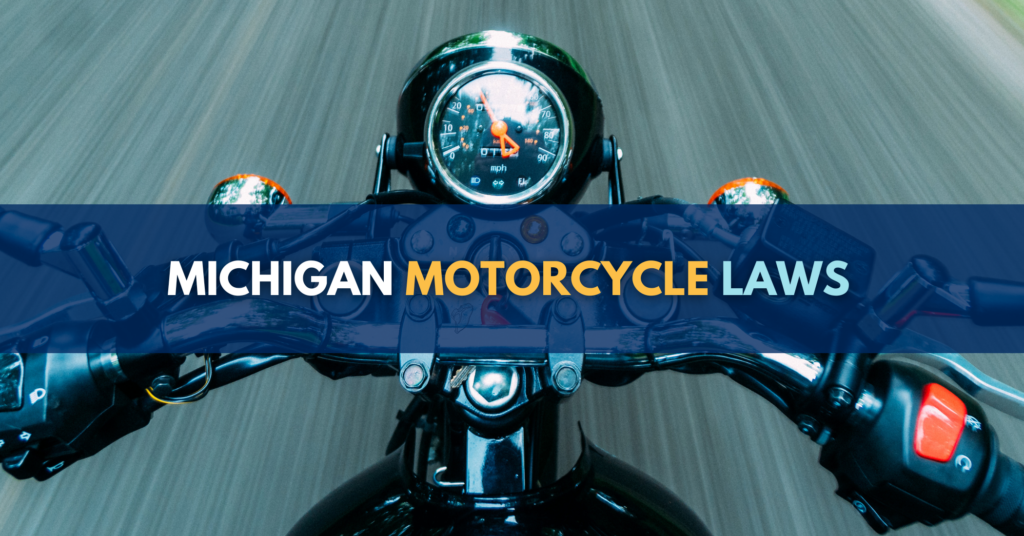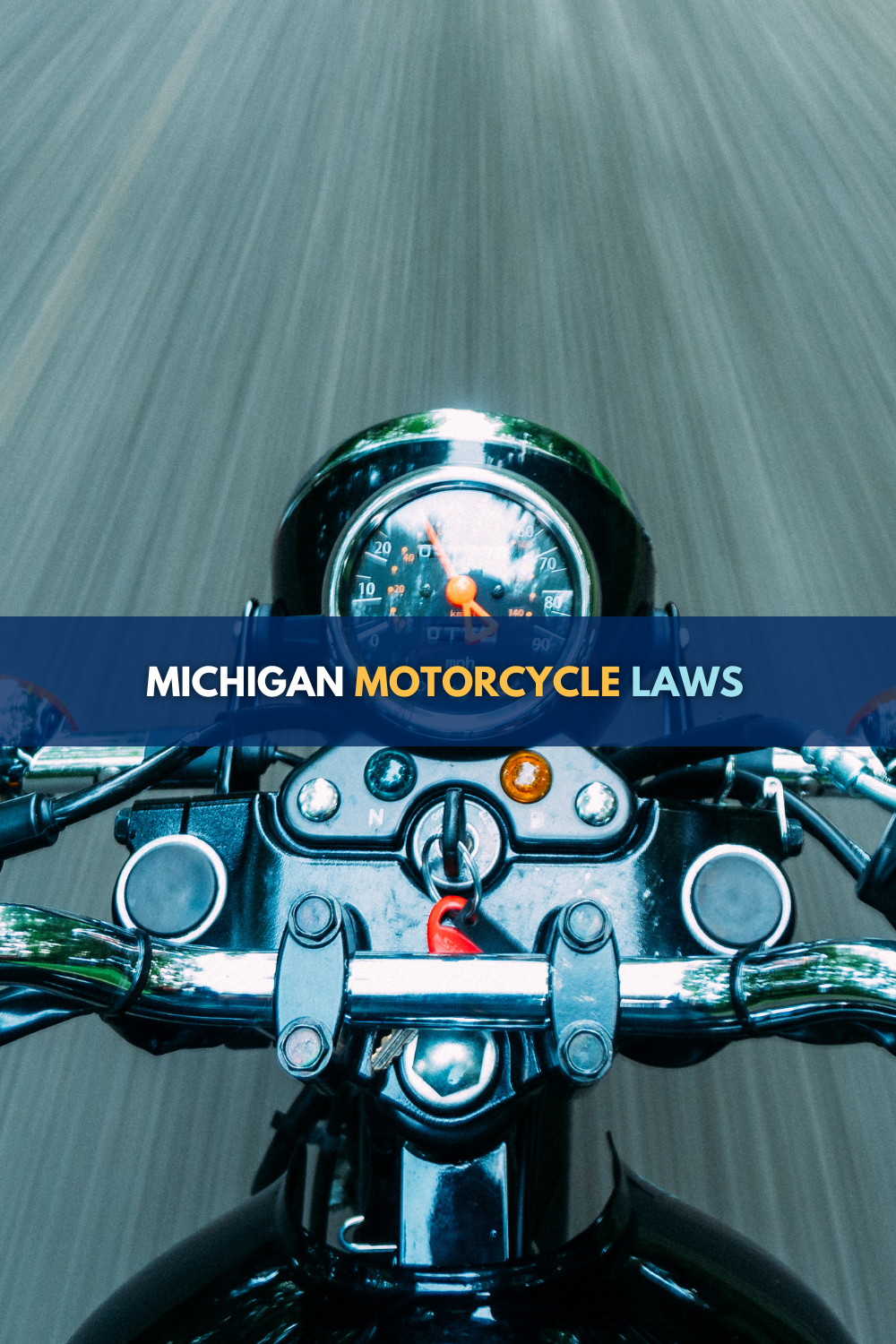Michigan Motorcycle Laws: Everything You Need To Know

The Michigan motorcycle laws require motorcyclists to be licensed, which means they must obtain a motorcyclist endorsement on their driver’s license before they ride. There are no set rules for how old a motorcyclist must be. Insurance is required and motorcyclists 20 and younger must wear crash helmets.
Is a motorcyclist license required in Michigan?
Yes. Before you can operate or drive a motorbike on roadways in the state, a person must first procure a motorcyclist endorsement on your driver’s license. (MCL 257.312a(1))
Do you have to have a driver’s license to get a motorcyclist license?
Yes. In order to get an endorsement, you must first have a driver’s license. The Michigan motorcycle laws state that an applicant for a motorcyclist endorsement must “first qualify for an operator’s license . . . before the endorsement . . . application is accepted and processed.” (MCL 257.310(1))
How old does a motorcyclist have to be to obtain a license?
There is no set rule on how old you have to be to get a motorcyclist license in the state. But you can be younger than 18. If you are “less than 18 years of age,” you must pass a safety course before you can get an endorsement on your operator’s or driver’s license. (MCL 257.312b(1))
According to the Michigan motorcycle laws how old do you have to be to get a license?
If you are 18 or older, you must “pass an examination” that includes a written knowledge test, road sign test, and driving skills test. (MCL 257.312b(2))
According to Michigan motorcycle laws how old do you have to be to operate one?
The laws do not specifically say how old you have to be to drive a motor bike. To get an endorsement, a person could likely be 17 or less because a driver’s license can be obtained at that age. But a 16- or 17-year-old may be able to obtain a “temporary instruction permit.”
The requirements that deal with the endorsement do not establish a minimum age requirement. (MCL 257.312a(1); 257.312b(1))
The requirements dealing with the issuance of a driver’s license – which a person must have before he or she can obtain an endorsement to operate a bike – state generally that an operator’s license will not be issued to a person “who is less than 18 years of age . . .” (MCL 257.303(1)(a))
However, the Michigan motorcycle laws qualify that statement by allowing that “a person who is 17 years of age or less” may be issued “an operator’s license” if his or her parent or guardian approves and if he or she “has satisfied the appropriate” graduated licensing “requirements . . .” (MCL 257.308(1); 257.310e(1))
However, the Michigan motorcycle laws qualify that statement by allowing that “a person who is 17 years of age or less” may be issued “an operator’s license” if his or her parent or guardian approves and if he or she “has satisfied the appropriate” graduated licensing “requirements . . .” (MCL 257.308(1); 257.310e(1))
Also, if you are “16 or 17 years of age” and you are enrolled in or you have successfully completed an approved safety course, then you may be issued a temporary instruction permit that allows you to operate a bike on state roadways for 180 days so long as certain conditions are met, such as riding under the supervision of a licensed motorcyclist and not riding at night or carrying passengers. (MCL 257.306(5))
How old do you have to be to ride a motorcycle in Michigan?
According to the Michigan motorcycle laws, there is no age requirement to ride a motorcycle, but there is a size requirement. A person can ride as a passenger so long as “his or her feet can rest on the assigned foot rests or pegs” unless the passenger is unable to do so “due to a permanent physical disability.” (MCL 257.658a(1))
Is there an age limit for riding as a passenger on a motorycle in Michigan,?
In Michigan, there is no age requirement to be a passenger on a motorcycle, but a passenger shall not ride on one “unless his or her feet can rest on the assigned foot rests or pegs,” except if “a permanent physical disability” prevents the passenger from doing so. (MCL 257.658a(1))
According to the Michigan motorcycle laws, how old do you have to be to ride on the back of one?
There is no requirement of how old you have to be to ride on the back of the bike. The only requirement is that your feet can reach the footrests or pegs designed for the passenger. (MCL 257.658a(1))
Plus, you can only ride on the back of a motor bike if it was designed and equipped to carry a passenger on the back. (MCL 257.658(2))
Can kids ride on motorcycles in Michigan?
In Michigan, there is no set age that a kid has to be to ride on a motorcycle. The same rule that applies to all passengers applies to kids. Regardless of their age, kids must be big enough for their feet to reach and rest on the footrests and/or pegs. (MCL 257.658a(1))
Do the Michigan motorcycle laws say anything about wearing a helmet?
Operators and riders who are 20 years of age or younger must wear crash helmets on their heads. Motorcyclists who are 21 or older can ride without a crash helmet if certain licensing, training and insurance requirements are met. (MCL 257.658(5))
Is motorcyclist insurance required?
According to the Michigan motorcycle laws all owners must have liability insurance to provide coverage if they cause an accident that results in death, bodily injury or property damage. (MCL 500.3103(1)) Motorcyclists who ride without helmets must have first-party medical benefits coverage. (MCL 257.658(5)) No-Fault is not required.
Can motorcyclists use a full traffic lane?
Motorcyclists have the legal right to “full use of a lane” and cars and trucks are prohibited from driving in way that deprives motorcyclists of the full use of the lane they are traveling in. (MCL 257.660(1))
Do the Michigan motorcycle laws state anything about motorcyclists riding side by side in a traffic lane?
Yes. But motorcycles cannot ride “more than 2 abreast” on public roads. (MCL 257.660(2))
Is lane splitting legal in Michigan?
According to the Michigan motorcycle laws lane splitting or white lining is illegal. A motorcyclist shall not pass between lines of traffic . (MCL 257.660(4))
Injured in a motorcyle accident in Michigan? Call the attorneys at Michigan Auto Law
If you were injured in motorcycle accident in Michigan, call now (855) 781-7747 for a free consultation with one of our experienced motorcycle accident lawyers. There is no cost or obligation. You can also visit our contact page or use the chat feature on our website.
Michigan Auto Law is Michigan’s largest and most successful law firm that specializes exclusively in helping people who have been injured in auto accidents.
Our secret? Our attorneys deliberately handle fewer cases than other personal injury law firms. This allows us to focus more time and attention on our cases.
Unlike other law firms, our attorneys are never too busy to promptly return phone calls and answer questions.
We have more than 2,000 5-Star Reviews that reflect this care and attention to detail.
More importantly, this client-focused approach leads to better and faster settlements for our clients. Michigan Auto Law has recovered more million-dollar settlements and trial verdicts for motor vehicle accidents than any other lawyer or law firm in Michigan. We’ve also recovered the highest ever reported truck accident and car accident settlement in the state.
Call now so we can start making a real difference for you.









